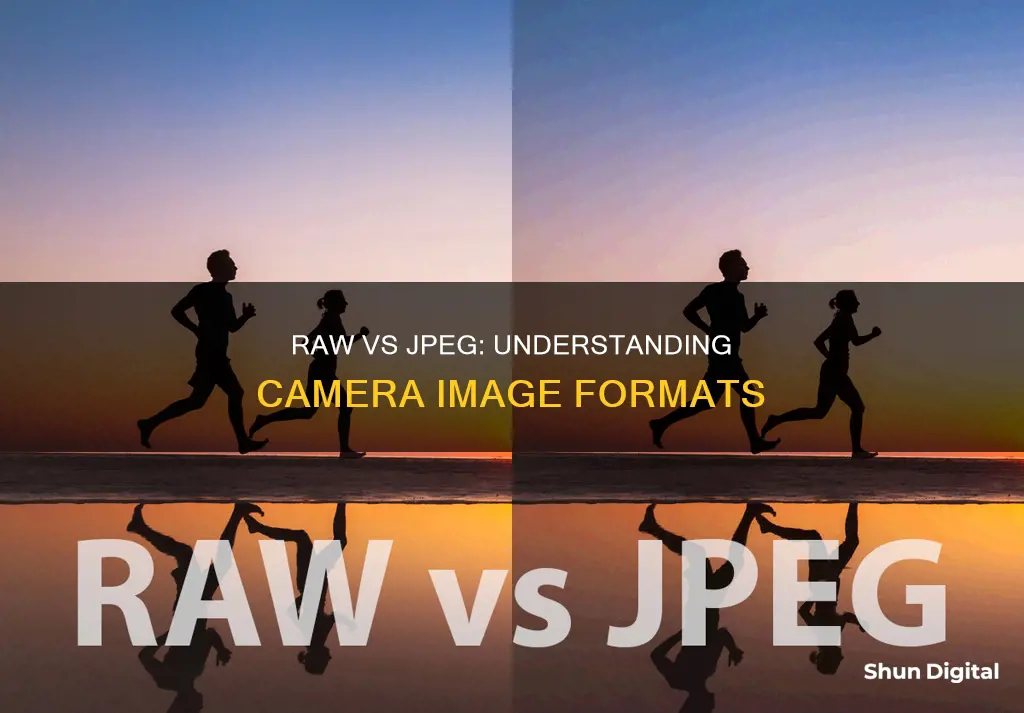
When it comes to photography, there are two main file formats that your camera can record: RAW and JPEG. RAW files are uncompressed and unprocessed, often described as digital negatives. They contain large amounts of data, offering more flexibility in editing software and allowing for more detailed and accurate adjustments to be made to the image. JPEG files, on the other hand, are compressed and processed by the camera, which reduces their size but also limits the possibilities for further editing. JPEGs are great if you don't want to edit your images, as they are ready to be uploaded or printed straight from the camera. However, if you want more control over the final image, RAW is the way to go.
| Characteristics | Values | |
|---|---|---|
| File type | RAW | JPEG |
| File format | Lossless | Compressed |
| File size | Larger | Smaller |
| Image quality | Higher | Lower |
| Post-processing | Required | Not required |
| White balance | Adjustable | Already balanced |
| Editing flexibility | More | Less |
| Storage space | More | Less |
| Compatibility | Less | More |
What You'll Learn

RAW files are uncompressed, whereas JPEGs are compressed
RAW files and JPEGs are two of the most popular image file formats used by photographers. They both have their own advantages and disadvantages, and the right choice depends on the photographer's needs and preferences. One of the main differences between the two formats is that RAW files are uncompressed, whereas JPEGs are compressed.
RAW files are often referred to as "digital negatives" because they contain all the uncompressed and unprocessed image data captured by a camera's sensors. They are like the raw ingredients of a photo that needs to be processed to bring out its full potential. RAW files are much larger in size compared to JPEGs because they contain all the raw image information without any compression. This makes RAW files ideal for situations where image quality and detail are crucial, such as when printing large-format images or when a high level of editing is required.
On the other hand, JPEG files are compressed versions of RAW files. The camera's image processor compresses the data to make the file smaller, which results in some loss of detail and quality. JPEGs are popular because they are more manageable in size, compatible with most devices and software, and require no additional processing after capture. JPEGs are also processed in-camera, so they look more finished straight out of the camera.
The compression used in JPEGs is called lossy compression, which means that some data is lost during the compression process. This can result in a decrease in image quality, with the image appearing grainy or pixelated. In contrast, RAW files are typically lossless, meaning they retain all the original detail and quality without any loss during compression.
The choice between shooting in RAW or JPEG depends on the specific needs and workflow of the photographer. RAW is often preferred by professionals who require the highest image quality and the most flexibility in post-processing. However, JPEGs are more suitable for situations where convenience, speed, and storage space are more important, such as when shooting in rapid succession or when immediate display of images is needed.
Charging Your Nikon: A Quick Guide to Powering Up Your Camera 3700
You may want to see also

JPEGs are processed in-camera, whereas RAW files are not
When it comes to photography, the file format you choose can significantly impact the final image. Two of the most common formats are JPEG and RAW. While JPEGs are processed in-camera, RAW files are not. Here are some key points to understand this difference:
- JPEGs are compressed versions of RAW files, making them smaller in size and more convenient for storage and sharing.
- RAW files, on the other hand, are unprocessed or minimally processed data straight from the camera sensor. They are often referred to as "digital negatives" and require post-processing to bring out the full potential of the image.
- In-camera processing: JPEGs undergo in-camera processing, where the camera adjusts the saturation, contrast, vibrance, and sharpness of the image. This results in JPEGs looking more finished straight out of the camera.
- RAW files, however, are left unprocessed by the camera, giving photographers full control over the final look of the image during post-processing.
- Flexibility: JPEGs offer less flexibility in post-processing compared to RAW files. Once the in-camera processing is done, making significant changes to a JPEG can result in posterization or other unwanted effects.
- RAW files, being unprocessed, provide greater flexibility. You can adjust the white balance, exposure, colors, and other settings without worrying about losing image quality.
- Compatibility: JPEGs are widely compatible and can be easily opened, viewed, and printed by most image-viewing and editing programs.
- RAW files, being proprietary formats, require specific software that is compatible with the camera model used to capture the image.
- Intended use: JPEGs are ideal for quick snapshots, social media posts, and situations where immediate results are needed without much post-processing.
- RAW files are better suited for professional photography, fine art, or any situation where image quality and flexibility in post-processing are prioritized.
Battery Life of Wireless Security Cameras: How Long?
You may want to see also

JPEGs are smaller in size, whereas RAW files are larger
JPEGs are "lossy" image files, meaning they lose some data from photographs. They are also 8-bit files, limiting them to 16.8 million colours.
RAW files, on the other hand, are "lossless" image files, meaning they capture all the uncompressed data from your camera sensor. They are much larger in size, typically between two and six times larger than a JPEG file. They offer greater flexibility in post-processing, with a wider dynamic range and a far greater colour spectrum.
The larger size of RAW files means that they require larger memory cards and that the cards will fill up more quickly. This can be a significant disadvantage, especially when shooting in burst mode.
JPEGs, due to their smaller size, are more easily transferable and can be stored in larger quantities. They are also compatible with most modern devices and software, making them a practical choice for everyday photography.
Charging Yi 4K Action Camera: A Step-by-Step Guide
You may want to see also

JPEGs are ready to use straight away, whereas RAW files require editing
JPEGs and RAWs are two different file formats for images. They differ in various ways, including their file size, image quality, and the level of processing required.
JPEGs are compressed versions of RAW files. They are processed in-camera, which means that images in this format are ready to use straight away. The camera adjusts the colour, contrast, and sharpness, so no further editing is required. This makes JPEGs ideal for event photography, sports, or any situation where quick turnaround is crucial. They are also smaller in size, which means they are easier to store and share.
On the other hand, RAW files are larger and require editing before they can be used. They are often referred to as "digital negatives" because they capture uncompressed data from the camera sensor. This results in a file that retains maximum detail and dynamic range. However, this means that RAW files must be edited to bring out their full potential. This can be done using photo editing software, which allows for extensive adjustments to the image without compromising its quality.
The choice between using JPEG or RAW depends on the photographer's needs and preferences. JPEGs are convenient for quick, ready-to-use images, while RAW provides more flexibility and control over the final image.
Best Cameras for RAW Photography: Unlocking the Power
You may want to see also

JPEGs are 8-bit, whereas RAW files are 12- or 14-bit
JPEGs are compressed versions of RAW files. They are smaller in size and are therefore easier to share. They are also processed in-camera, so they look more finished straight off the camera. However, they have a limited colour and tonal spectrum, and are therefore not ideal for editing.
RAW files, on the other hand, are much larger in size and are therefore not conducive to emailing. They also need to be converted to a format such as JPEG or TIFF before they can be displayed online. However, they offer much more flexibility when it comes to editing. They are also lossless, meaning they capture uncompressed data from the camera sensor.
The RAW Truth: Original Files Safe or Deleted?
You may want to see also
Frequently asked questions
A JPEG image is a processed and compressed version of a photo. When you capture a photo in JPEG format, the camera processes the image data according to its built-in settings and compresses it to reduce file size. JPEGs are ideal for quick use without extensive post-processing.
A RAW image is essentially a digital negative. When you capture a photo in RAW format, the camera records all the data from the sensor without any compression or processing. This results in a file that retains maximum detail and dynamic range, providing flexibility for post-processing. RAW images require post-processing and are larger in size compared to JPEGs.
JPEG is ideal for beginners, event photography, sports, or any situation requiring quick turnaround times. JPEGs are smaller in size, making them efficient for storage and sharing. RAW offers unparalleled control and quality, making it preferred for professional and serious photographers. RAW provides immense flexibility in post-processing, allowing for extensive adjustments without compromising image quality.







